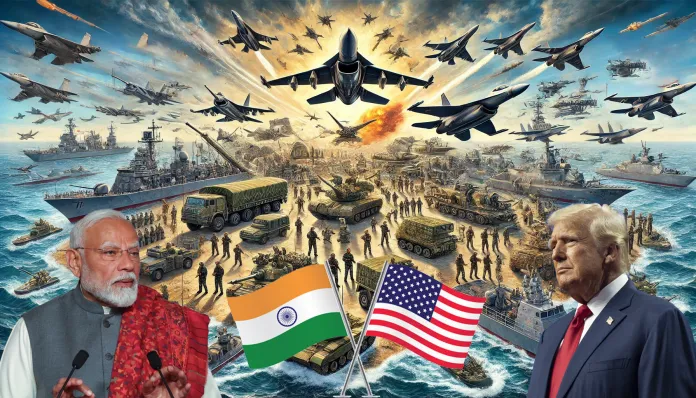Navigating Tensions: Trump, India, and Ceasefire Dynamics
In the intricate web of international relations, the interplay between diplomatic engagements and ceasefire agreements remains a pivotal aspect of peacekeeping and conflict resolution. This article delves into how the Trump administration’s foreign policy stance towards India and its approach to ceasefire negotiations have influenced global geopolitical dynamics. By examining key moments and decisions, we uncover the nuances of strategies aimed at fostering peace and stability in regions marked by tension.
The Trump Doctrine and India’s Strategic Position
The Trump administration’s America First policy reshaped U.S.-India relations, positioning India as a key strategic partner to counterbalance China’s influence in the Indo-Pacific. Trump’s transactional diplomacy prioritized defense and trade ties, culminating in agreements like the COMCASA for military interoperability. However, his approach to Pakistan was inconsistent—oscillating between pressure over terrorism and tacit support for ceasefires in Kashmir. India leveraged this ambiguity to strengthen its regional stance, even as Trump’s unpredictability complicated long-term stability. The administration’s focus on short-term gains often overshadowed deeper strategic alignment.
Ceasefires in Theory and Practice
Ceasefires serve as critical tools in conflict management, bridging the gap between war and peace. Formal ceasefires, often codified in treaties, carry legal weight and involve third-party oversight, while informal agreements rely on mutual but tacit understandings, often fragile and context-dependent. Strategically, ceasefires can de-escalate violence, create space for dialogue, or serve as tactical pauses for regrouping. For instance, the 2020 India-Pakistan LoC ceasefire, brokered amid Trump’s engagement, demonstrated how informal arrangements can stabilize tensions without formal treaties. However, their success hinges on trust, enforcement mechanisms, and alignment with broader diplomatic goals—factors often tested in volatile regions like South Asia.
Historical Context: India-Pakistan Ceasefires
The historical context of India-Pakistan ceasefires is rooted in the Karachi Agreement of 1949, which established the first formal ceasefire line in Kashmir after the First Indo-Pak War. Subsequent agreements, like the Tashkent Declaration (1966) and Simla Accord (1972), reinforced ceasefire mechanisms but often failed to address underlying territorial disputes. These precedents highlight a pattern of temporary de-escalation without lasting resolution, shaping today’s reliance on reciprocal restraint and third-party mediation. The 2003 LoC ceasefire, though fragile, remains a benchmark for stability, illustrating how past frameworks influence current negotiations amid recurring tensions.
Impact of Trump’s Policies on South Asia
Under Trump, U.S. policy in South Asia shifted toward a transactional approach, favoring India as a strategic counterweight to China. His administration curtailed aid to Pakistan, pressuring Islamabad to curb militant activities, which indirectly bolstered India’s stance in Kashmir. Trade tensions, like tariffs on Indian steel, strained economic ties, yet defense cooperation deepened with agreements like COMCASA. This recalibration altered regional dynamics, emboldening India’s assertive posture while isolating Pakistan. The U.S. withdrawal from Afghanistan further complicated the landscape, leaving India to navigate heightened instability with diminished American engagement.
Ceasefire Challenges and Opportunities
Implementing and sustaining ceasefire agreements often faces challenges like mistrust between parties and violations due to ambiguous terms. Third-party mediators, such as the U.S. under Trump, played a crucial role in de-escalating India-Pakistan tensions, leveraging diplomatic pressure to reinforce commitments. Confidence-building measures, like cross-border trade or communication channels, are vital but fragile under domestic political pressures—hardline rhetoric or electoral agendas can undermine progress. The durability of ceasefires hinges on balancing external mediation with internal political will, a dynamic evident in South Asia’s volatile ceasefire history.
The Role of International Organizations
International organizations, particularly the United Nations, have played a pivotal role in mediating ceasefires involving India, especially during heightened tensions under Trump’s administration. The UN Military Observer Group in India and Pakistan (UNMOGIP) has monitored ceasefires in Kashmir, though its effectiveness remains contested. Multilateral bodies like the Shanghai Cooperation Organization (SCO) have also provided platforms for dialogue, albeit with limited influence. While these entities facilitate confidence-building measures, their impact is often constrained by geopolitical rivalries and the reluctance of states to cede sovereignty. Their role, though symbolic, underscores the complexities of external mediation in bilateral disputes.
Evaluating Trump’s Legacy in India-U.S. Relations
Under Trump’s presidency, India-U.S. relations saw both turbulence and strategic deepening. Trade tensions flared over tariffs, yet defense cooperation surged with agreements like COMCASA, enhancing military interoperability. Trump’s transactional approach strained diplomatic norms but accelerated India’s role as a counterbalance to China in the Indo-Pacific. The Quad gained momentum, reflecting shared security interests. However, erratic policies on issues like H-1B visas created uncertainties. While short-term friction existed, Trump’s tenure reinforced long-term strategic alignment, setting a foundation for future collaboration despite lingering economic disputes.
India’s Response to Global Ceasefire Initiatives
India has consistently balanced its support for global ceasefire initiatives with its strategic interests, particularly in regions like Kashmir. While endorsing UN peacekeeping missions, New Delhi remains cautious about external mediation in bilateral disputes. Under Trump, India faced pressure to engage in ceasefire talks with Pakistan, but it resisted, emphasizing direct dialogue over third-party intervention. This stance reflects India’s broader policy of safeguarding sovereignty while projecting itself as a responsible global actor. The approach underscores the tension between multilateralism and national security priorities in its foreign policy calculus.
Lessons Learned: Diplomacy and Ceasefire Negotiations
Trump’s approach to diplomacy and ceasefire negotiations emphasized transactional pragmatism, leveraging direct engagement and public pressure. His administration’s hands-on style, seen in Kashmir and Afghanistan, highlighted the effectiveness of high-profile mediation but also exposed risks of unpredictability. Key lessons include the need for clear strategic objectives behind ceasefires and balancing public posturing with backchannel diplomacy. Future strategies must account for domestic political influences on foreign policy while ensuring sustained multilateral coordination, as unilateral moves can destabilize long-term conflict resolution efforts. This underscores the delicate interplay between power projection and diplomatic finesse.
Future Paths: The Road Ahead for India, Trump, and International Peace
Future Paths: The Road Ahead for India, Trump, and International Peace
The evolving geopolitical landscape under Trump’s potential return or enduring influence could reshape India’s strategic calculus, particularly in conflict zones where ceasefires remain fragile. India, balancing its non-aligned roots with growing U.S. ties, may leverage Trump’s transactional diplomacy to secure favorable terms in regional disputes. However, reliance on unpredictable U.S. leadership risks destabilizing long-term peace frameworks. Innovations in digital diplomacy and AI-driven conflict resolution could supplement traditional negotiations, offering neutral ground for de-escalation. The challenge lies in aligning short-term gains with sustainable peace, ensuring India’s autonomy while engaging global power dynamics.

Conclusions
The interaction between Trump’s foreign policy and India’s strategic imperatives against the backdrop of ceasefire agreements offers a complex mosaic of challenges and opportunities. The article underscores the critical role of diplomacy and strategic negotiations in navigating the uncertain waters of international relations, highlighting the importance of adaptability, strategic foresight, and international cooperation in fostering peace and stability.



